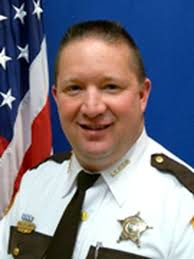Humans hunting humans is a problem says Cass County Sheriff Paul Laney.
Laney spoke out in the wake of the shooting that killed Fargo Police Officer Jason Moszer during a stand-off Wednesday.
"How do you think that hits us? People are hunting us. And how do you think that sits with us? Yet we wear this badge with honor and pride and we're going to go out every day and protect our community," Laney said.
Laney’s ‘predator and prey’ analysis to characterize the fatal shooting of a police officer has captured the essence of a serious national epidemic.
People hunting people.
 |
| Cass County Sheriff Paul Laney |
Laney’s expression has entered the dialogue of concerned Americans that believe the lives of "community" members such as Steven Avery – the Wisconsin man featured in the Netflix documentary Making a Murder - are all valuable lives.
81 percent of American’s believe Avery is innocent according to a January, 2016 poll.
The North Dakota sheriff’s ‘hunting’ analysis has given rise to a conversation regarding the unavailability of police records and bizarre under-reporting of an officer-involved shooting in Grand Forks, North Dakota in 2015.
The 2015 shooting of David James Elliott involved the actual ‘hunt’ of a man by police for over two hours; the details of which have being seemingly hidden since the very beginning.
Hidden facts, circumstances, and obfuscated evidence are primary components of the rapidly spreading Steven Avery Syndrome.
In February of 2015, a University of North Dakota Police officer unloaded 12 rounds into the vehicle cab of David Elliott; an unarmed man that had managed to roll his hobbled vehicle to the emergency room entrance of a hospital. There in the parking lot while on the telephone he was shot - he was hit six times – three time in the head - once in the face – but survived.
The details of the hours leading up to the event are by any standard, very mysterious.
Elliott, unarmed, with no criminal record, telephoned 911 shortly after police began pursuing him and is believed to have told 911 why he refused to stop.
It is known three police officers were suspended following the event but no updates have ever been given.
The bizarre actions of law enforcement were captured in a scathing editorial by the Grand Forks Herald.
North Dakota law enforcement will not relay to the public what Elliott told 911 or provide a timeline of events regarding the pursuit, which involved the Grand Forks Police Department, Grand Forks Sheriff’s Office, North Dakota Highway Patrol, and University of North Dakota Police.
Only after a formal document request was made for the records by Write Into Action, did police release video to WDAZ TV. The news piece only featured officer-cam segments from the high-speed chase but did not mention the 911 call or explain why Elliott fled.
The 911 call and officer cam video, which will reveal the route of the Elliott pursuit (which could involve another State - Minnesota), and reveals what he was saying to 911 while officers that were behind him without their red-lights activated, is not readily available to the public.
Law enforcement has presented the two hours long event as ‘two separate pursuits’ while describing the pursuit in the middle of the event as officers simply “following” Elliott through the night.
Why North Dakota law enforcement is concealing the details of Elliott's 911 call is not known.
Following the Elliott shooting in 2015, North Dakota law enforcement stonewalled the media and refused to communicate with the public about what happened.
The bizarre nature of the Elliott pursuit and shooting is illuminated by North Dakota law enforcement’s complete opposite reaction to the shooting of Fargo Police Officer Jason Moszer.
In the Moszer shooting, law enforcement has adhered to the law and been very transparent – immediately alerting the media to the public safety issue and providing regular updates.
All of the same law enforcement agencies involved in the Elliott shooting are reportedly involved in the Moszer situation, including the Police Department, North Dakota Highway Patrol, Sheriff’s Office, and BCI.